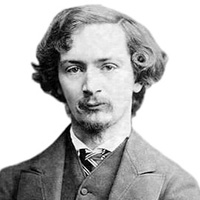The Garden of Proserpine by Algernon Charles Swinburne: Summary and Analysis
The Garden of Proserpine is composed by Algernon Charles Swinburne in 1866 published in his collection Poems and Ballads. This poem addresses the myth of Greek Pagan Goddess Proserpine, who is the daughter of Demeter also known as Ceres; Goddess of agriculture and crops and Jupiter who is the God of sky and thunder.

Algernon C. Swinburne (1837-1909)
Proserpine is supposed to spend half of the year on the earth and the rest of the year with her husband Pluto under the world who ruled the world of the dead. According to the Greek mythology, when Proserpine returns to the earth, spring season comes with bloom and harvest, but the moment she goes back to the underworld everything withers and turns to brown and winter comes. In this sense, Proserpine, also spelled as Persephone in Latin, is the symbol of death and rebirth.
Swinburne’s poem The Garden of Proserpine brings Proserpine’s clashing relationship with both life and death to demonstrate the complex yet complementary nature of life and death. In the poem the Garden of Proserpine, a dead speaker is speaking from the underworld and describing everything around him. He directly states that death is inevitable irrespective of one’s power and physical strength. The final destination of every human being is death and here the speaker denounces the prevailing idea of Christian philosophy, saying that death is final and there is no heaven and hell. He further presents his idea about love and beauty which is also perishable along with the death of a person.
Proserpine is described as a ‘pale’ and ‘cold’ figure that closely stand for the death who collects all the human souls as if she is harvesting her crops. When her hands are called ‘cold immortal hands’ the speaker is again focusing on the permanence of the death and the transient nature of the physical world. During the winter season, Proserpine causes death and withering in all the fruits, flowers, crops and trees. She does not remember her mother Demeter, who is the goddess of crops and fruits of the earth. Contrary to this, when she returns to the earth, she brings joy with greenery and causes rebirth of the crops, fruits and flowers on the earth. It is highly focused that despite the outer vitality of the earth, it does not have the power of permanence. All the things that have life on the earth are a part of a cycle of small deaths. They die in the winter and get life again in the spring. The mini deaths are balanced by the rebirths. Because the death is a part of life, the speaker celebrates on the arrival of the death. He is of the view that death liberates us from the unnecessary fear and never ending hope. It is silent and peaceful break from the hectic way of living.
Death, for the speaker is eternal sleep from which no one wakes up again when he says ‘dead men rise up never’. Here, the rejection of Christian philosophy is noticed. For the Christians, there is after life and everyone rises at the Day of Judgment, but, the speaker rejects the idea being the spokesperson of Algernon Charles Swinburne and claims that death is final. The metaphor of ‘the weariest river’ peacefully merging in the calm sea in the final suggest that death is a natural process and the inevitable thing. It is the final happiness and peace, we receive in the form of death. This cycle is all natural and necessary. As Proserpine faces death on every winter season and it has become a part of life to her, she is the symbol of small deaths that also contains everyday life.
The poet symbolizes Proserpine as a kind of knot of life and death, which is impossible to untie. She is the threshold between life and death. She contains both death and life. With her reference, the poet comes to the conclusion that our life is also like the life of Proserpine. We too have small deaths on a daily basis and every day we get new life. Small deaths balance our life in the way night balances day, sleep balances rest and dark balances light.
The Garden of Proserpine raises the core issue of the crisis in the Victorian faith. The dictions and metaphors like ‘who gathers all things mortal; with cold immortal hands’, ‘Here life has death for neighbour’ and ‘Whatever gods may be’ questions on the doctrine of Christianity and the poet proclaims his belief in paganism. His dictions and metaphors asserts his negativity towards the religion.
The poem has some paradoxes like Proserpine. She herself is a paradoxical figure as she resembles both birth and death. Next, the garden of Proserpine is also paradoxical; generally a garden is a place where life of flowers and fruits bloom, but since this garden is in the underworld it only generates death. The poem has twelve stanzas with eight lines in each stanza. Its rhyming scheme is ABABCCCD and stress is put at the end of the poem.
